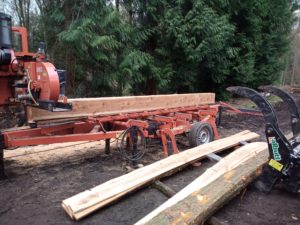Since I checked in last autumn and with spring finally upon us, I have now witnessed a large part of the forestry year. A significant milestone has been the submission of a woodland management plan and being involved in the process from start to finish – from the initial baseline surveys, to formulating, discussing and finalising working protocols with both the owner and the Forestry Commission. After all of the hard work, alongside having many other plans in the pipeline, it was a satisfying feeling to recently get the nod of approval from the local woodland officer.
The onset of winter was the start of the planting season. With the delivery of around 7000 seedlings sourced from nurseries across the country, I organised the plants ready for dispatch to their new homes. With half (representing 20 broadleaf species) retained for a native woodland creation project, the remaining seedlings were destined to ‘beat-up’ (replace losses in young plantations), or to start their life ‘under-planted’ beneath the canopy in the hope of providing a structurally diverse crop and future timber.
Having helped Dr Clark and Dr Beesley – researchers from the Future Trees Trust – collect data on an oak (Quercus robur/petraea) progeny trial in the bitter cold of late November, it was great to see that consideration had been given to source ‘selected’ oak and sycamore (Acer pseudoplatanus) for one of the estates. However, with only improved birch, sycamore and cherry planting stock available of the common timber species used in the South of England, there is still much work to be done!
As well as tree planting, winter dormancy provides other opportunities for forest managers. More recently, I have been out doing mensuration work – a much simpler task when deciduous trees are not in leaf. This involves calculating the merchantable volume of timber within a stand by taking average measures of height and basal area. In addition to record keeping, this information can be used to determine the yield class (growth rate), or the threshold basal area, a parameter used to clarify whether the stand is ready for thinning.
We are now reaching the end of our marking work, which involves selecting trees to be felled in a thinning operation. Following planting and successful establishment (with trees free from browsing and ahead of weed competition) stands may be cleaned (removing undesirable competing species) and selected individuals may be pruned. Once the stand is fully established, the thinning cycle begins and depending how far advanced the crop is we may be selecting trees to remove for a number of reasons. Usually, we will be removing the poorest quality trees to give the best trees room to develop. But, sometimes we are selecting individuals of the right quality for a particular market, or we may be opening up the stand to increase light levels which further promotes natural regeneration and stand diversity. Overall, selection is a considered process with a number of factors affecting the decision, for example timber quality, spacing, access, structure, diversity, markets, thinning intensity and potential for growth. Admittedly, I was a little wary when William first thrust a can of paint in my hand. After all, many of the trees have seen more years than I have… but witnessing the improvement in the stand once the operation is complete, as well as seeing the produce going to market demonstrates the benefit of the operation and gives a rewarding feeling of a job well done.
Another notable project has been the recent work at Herriard Estate where the need to replace the flooring in the Parish church involved us sourcing 550 hoppus ft (19.8 cu.m) of red oak (Quercus rubra) timber. We met the owner, sawmillers, architects and parish councillors in order to establish the desired specification. Once this was finalised, we determined the volume and minimum top diameter necessary to maximise use of the timber and set out to select the trees. The logs are now being cut, dried and processed in the mill, preparing for a long life as carbon-storing floor boards.
A similar project involved the careful selection of western red cedar (Thuja plicata) in order to provide cladding for some estate renovation work. The trees were felled producing seven cubic metres of timber and just a few days later were milled with a Wood-Mizer mobile saw, not far from where they used to stand (Figures 1 & 2). In total this produced around 240 superb (7 inch) feather-edged boards, as well as other square-edged materials. It was impressive to see the full procedure from standing trees to a stacked pile of boards, all in the middle of the forest.
I have realised that foresters are true multi-taskers! During the past few months, it has been all hands-on-deck organising both people and plants. As the ground hardens up work with harvesters and forwarders can begin, meaning trees must often be marked beforehand. Year-round, timber is being sold and transported to sawmills, biomass and firewood businesses, requiring measuring and grading prior to collection. Meetings with clients and contractors are a constant. Grant applications must be well-considered and submitted to meet their deadlines. Multiple management plans requiring consultation with statutory bodies, surveys, crop inventories and lots of GIS need constant behind the scenes engagement.
Meticulous advanced planning is crucial. We have been busy applying for a woodland creation project for next year, with many considerations to manage. First, we must check what the local soil conditions offer and determine what species are suitable. Then we must consider how trees will impact the local landscape character, existing ancient woodland, local ecology and the wider environment. Navigating through the labyrinth that is the grant system is particularly time consuming and we must also consider the economic potential of the new woodland to sequester carbon. The prospect of a new well-designed woodland presents a multitude of benefits, but ultimately someone also needs to pay for it!
For now, this should give you a taste of what I’ve been up to since I last checked in. Although as previously mentioned, there is a lot going on behind the scenes, perhaps too much to mention in this blog post. Overall, the job is very rewarding and there is always something to learn. In the UK a large proportion of woodlands are in need of forward-thinking management, meaning there is plenty of opportunity for a budding young forester entering the industry.
If you have a passion for trees and the environment, life as a forest manager could be for you!
Figure 1. Wood-Mizer mobile sawmill
Figure 2. Red Cedar feather-edged boards




Leave A Comment